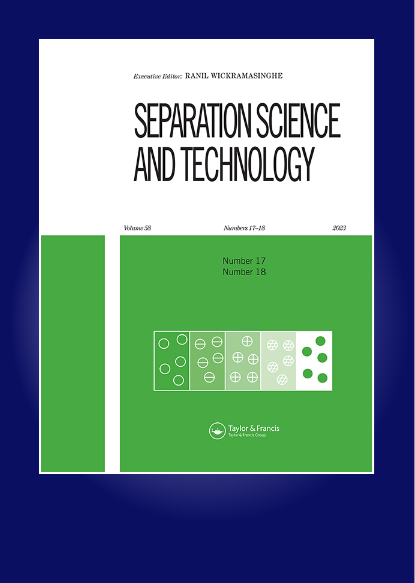Adsorption of Diethylenetriamine from Water by Activated Carbon: Kinetics, Isotherms and Thermodynamics
IF 2.3
4区 工程技术
Q3 CHEMISTRY, MULTIDISCIPLINARY
引用次数: 0
Abstract
ABSTRACT The discharge of diethylenetriamine (DETA) into aqueous environment poses a threat to public health and environment. Therefore, it is imperative to take effective measures to remove DETA from water. The elimination of DETA from water may be realized via the way of adsorption with activated carbon. In this paper, the adsorption of DETA from water by activated carbon originated from coconut shell has been explored in batchwise operation. The effects of stirring speed, temperature, pH, DETA concentration, carbon dosage and particle size on DETA adsorption have been determined by experiment. The adsorption results exhibit that the DETA adsorption rate increases with its concentration in the aqueous solution and temperature. However, the amount of DETA adsorbed on the carbon at equilibrium decreases slightly with temperature. The DETA adsorbed increases with pH changing from 8 to 11 and remains constant if pH rising over 11. The kinetic study shows that DETA adsorption on the activated carbon is in good agreement with the pseudo-second-order kinetic model with a correlation coefficient of 0.999. The DETA removal from the solution increases with the carbon dosage. The Langmuir equilibrium isotherm model has been found to provide a better fitting of the adsorption data than the Freundlich equilibrium isotherm model with a maximum adsorption of 90.50 mg g−1. The thermodynamic parameters evaluated from the experiments are ΔS 14.49 J∙mol−1∙K−1, ΔH −11.32 kJ mol−1 and ΔG changing from −15.71 from −16.15 kJ mol−1with the temperature rising from 30°C to 60°C. The thermodynamic study suggests the exothermic and spontaneous natures of DETA sorption on activated carbon.活性炭吸附水中二乙基三胺:动力学、等温线和热力学
二乙烯三胺(DETA)排放到水环境中对公众健康和环境构成威胁。因此,采取有效措施去除水中的DETA势在必行。通过活性炭吸附的方法可以实现水中DETA的去除。研究了以椰壳为原料的活性炭对水中DETA的批量吸附。通过实验确定了搅拌速度、温度、pH、DETA浓度、碳投加量和粒径对DETA吸附的影响。吸附结果表明,DETA在水溶液中的吸附速率随浓度和温度的增加而增加。然而,在平衡状态下,吸附在碳上的DETA量随着温度的升高略有下降。当pH值在8 ~ 11范围内变化时,吸附的DETA增加,当pH值大于11时,吸附的DETA保持不变。动力学研究表明,活性炭对DETA的吸附符合拟二级动力学模型,相关系数为0.999。随着碳投加量的增加,溶液中DETA的去除率增加。Langmuir平衡等温线模型比Freundlich平衡等温线模型能更好地拟合吸附数据,最大吸附量为90.50 mg g−1。实验得到的热力学参数为ΔS 14.49 J∙mol−1∙K−1,ΔH−11.32 kJ mol−1,ΔG随着温度从30℃升高到60℃,从−15.71到−16.15 kJ mol−1变化。热力学研究表明,活性炭吸附DETA具有放热性质和自发性质。
本文章由计算机程序翻译,如有差异,请以英文原文为准。
求助全文
约1分钟内获得全文
求助全文
来源期刊

Separation Science and Technology
工程技术-工程:化工
CiteScore
6.10
自引率
3.60%
发文量
131
审稿时长
5.7 months
期刊介绍:
This international journal deals with fundamental and applied aspects of separation processes related to a number of fields. A wide range of topics are covered in the journal including adsorption, membranes, extraction, distillation, absorption, centrifugation, crystallization, precipitation, reactive separations, hybrid processes, continuous separations, carbon capture, flocculation and magnetic separations. The journal focuses on state of the art preparative separations and theoretical contributions to the field of separation science. Applications include environmental, energy, water, and biotechnology. The journal does not publish analytical separation papers unless they contain new fundamental contributions to the field of separation science.
 求助内容:
求助内容: 应助结果提醒方式:
应助结果提醒方式:


